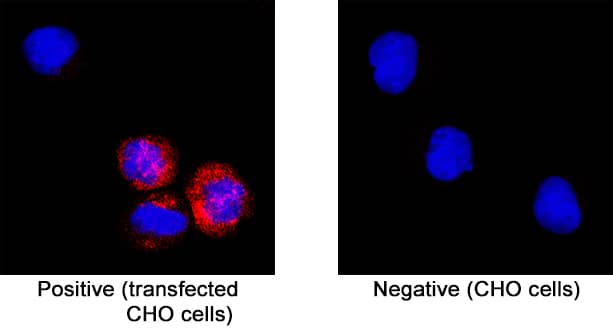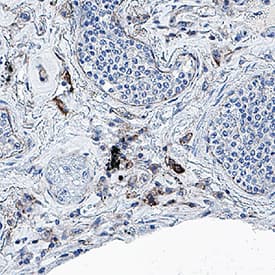SARS-CoV-2 Envelope Antibody
R&D Systems, part of Bio-Techne | Catalog # MAB10925


Conjugate
Catalog #
Key Product Details
Species Reactivity
SARS-CoV-2
Applications
Immunocytochemistry, Immunohistochemistry
Label
Unconjugated
Antibody Source
Monoclonal Mouse IgG1 Clone # 1044554
Product Specifications
Immunogen
Chinese hamster ovary cell line CHO-derived recombinant human SARS2-CoV-2 Envelope
Thr35-Val75
Accession # YP_009724392
Thr35-Val75
Accession # YP_009724392
Specificity
Detects human SARS2-CoV-2 Envelope in direct ELISAs.
Clonality
Monoclonal
Host
Mouse
Isotype
IgG1
Scientific Data Images for SARS-CoV-2 Envelope Antibody
SARS-CoV-2 Envelope in CHO Chinese hamster cell line transfected.
SARS-CoV-2 Envelope was detected in immersion fixed CHO Chinese hamster ovary cell line transfected (positive staining) and CHO Chinese hamster ovary cell line (non-transfected, negative staining) using Mouse Anti-SARS-CoV-2 Envelope Monoclonal Antibody (Catalog # MAB10925) at 8 µg/mL for 3 hours at room temperature. Cells were stained using the NorthernLights™ 557-conjugated Anti-Mouse IgG Secondary Antibody (red; NL007) and counterstained with DAPI (blue). Specific staining was localized to cytoplasm. Staining was performed using our protocol for Fluorescent ICC Staining of Non-adherent Cells.SARS-CoV-2 Envelope in SARS-CoV-2 infected human lung.
SARS-CoV-2 Envelope was detected in immersion fixed paraffin-embedded sections of SARS-CoV-2 infected human lung using Mouse Anti-SARS-CoV-2 Envelope Monoclonal Antibody (Catalog # MAB10925) at 5 µg/mL for 1 hour at room temperature followed by incubation with the Anti-Mouse IgG VisUCyte™ HRP Polymer Antibody (VC001). Before incubation with the primary antibody, tissue was subjected to heat-induced epitope retrieval using Antigen Retrieval Reagent-Basic (CTS013). Tissue was stained using DAB (brown) and counterstained with hematoxylin (blue). Specific staining was localized to immunoreactive profiles scattered throughout the tissue. Staining was performed using our protocol for IHC Staining with VisUCyte HRP Polymer Detection Reagents.Applications for SARS-CoV-2 Envelope Antibody
Application
Recommended Usage
Immunocytochemistry
8-25 µg/mL
Sample: Immersion fixed CHO Chinese hamster ovary cell line transfected with SARS-CoV-2 E
Sample: Immersion fixed CHO Chinese hamster ovary cell line transfected with SARS-CoV-2 E
Immunohistochemistry
5-25 µg/mL
Sample: Immersion fixed paraffin-embedded sections of SARS-CoV-2 infected human lung
Sample: Immersion fixed paraffin-embedded sections of SARS-CoV-2 infected human lung
Formulation, Preparation, and Storage
Purification
Protein A or G purified from hybridoma culture supernatant
Reconstitution
Reconstitute at 0.5 mg/mL in sterile PBS. For liquid material, refer to CoA for concentration.
Formulation
Lyophilized from a 0.2 μm filtered solution in PBS with Trehalose. *Small pack size (SP) is supplied either lyophilized or as a 0.2 µm filtered solution in PBS.
Shipping
Lyophilized product is shipped at ambient temperature. Liquid small pack size (-SP) is shipped with polar packs. Upon receipt, store immediately at the temperature recommended below.
Stability & Storage
Use a manual defrost freezer and avoid repeated freeze-thaw cycles.
- 12 months from date of receipt, -20 to -70 °C as supplied.
- 1 month, 2 to 8 °C under sterile conditions after reconstitution.
- 6 months, -20 to -70 °C under sterile conditions after reconstitution.
Background: Envelope
References
- Malik, Y.A. (2020). Properties of Coronavirus and SARS-CoV-2. The Malaysian Journal of Pathology.
- Yoshimoto F.K. (2020) The Proteins of Severe Acute Respiratory Syndrome Coronavirus-2 (SARS CoV-2 or n-COV19), the Cause of COVID-19. The Protein Journal. https://doi.org/10.1007/s10930-020-09901-43.
- Uniprot (P0DTC4).
- J. Alsaadi, E.A., & Jones, I. M. (2019). Membrane binding proteins of coronaviruses. Future Virology. https://doi.org/10.2217/fvl-2018-0144.
Long Name
Envelope Protein
Alternate Names
E Protein
Entrez Gene IDs
43740570 (SARS-CoV-2)
Gene Symbol
E
UniProt
Additional Envelope Products
Product Documents for SARS-CoV-2 Envelope Antibody
Product Specific Notices for SARS-CoV-2 Envelope Antibody
For research use only
